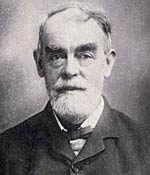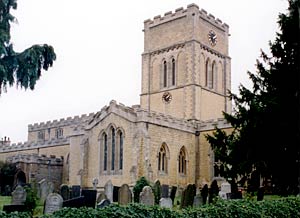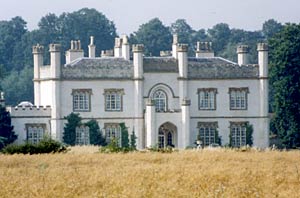< Previous | Contents | Next >
Cathedral of the Vale
LANGAR. A quiet little red and green village which we remember for its many fine trees, it was the birthplace of a famous philosopher and is the sleeping-place of a famous admiral, and it was long the home of a family that comes into a pathetic scene in Shakespeare.

Samuel Butler (1835-1902).
Its beautiful church stands by an open field looking over the Vale of Belvoir. The churchyard gate opens under a yew arch to a peace memorial cross, and next door to the church is the ivied hall, its lawn coming up to the west wall. It is a modern house on the site of the old home of the Howes. Within a stone's throw are the 19th century gabled school and the spacious rectory where Samuel Butler was born just before the Victorian Era began. He was brought up rather unhappily in an extremely Puritan home, and he brings the village into the philosophical book that is really his autobiography, The Way of All Flesh. Langar in this book is called Battersby-on-the-Hill. The Way of All Flesh is one of his two famous books, the other bearing the curious title of Erewhon, which he made by transposing the letters of the word Nowhere. It is a satirical Utopia, in which Butler imagines a race that has evolved beyond the use of machinery, and has got rid very largely of the weaknesses of human nature and the failures of our imperfect civilisation. Butler, first meant for the Church, wished to be an artist, but was driven at 24 to sail for New Zealand to try his fortune as a sheep farmer. There he wrote for a local newspaper the first of two articles out of which his novel Erewhon was to grow. After five years he was able to sell his sheep farm at a handsome profit, come home again, and begin to study art, but in the end he turned to literature, and Erewhon appeared in 1872.

Langar church in 2003.
Well deserving its name of the Cathedral of the Vale, the church has the shape of a cross with a noble central tower. Though it looks almost new outside with its 19th century dress of rich amber stone, it was built in the 13th century, when it may have accommodated the pilgrims to the ancient church of St Ethelburga, whose site has lately been found again in a field.
The tower has a band of medieval lancets under a corbel table with worn heads. For over 500 years the porch has sheltered a panelled door with a small wicket, opening to the charming interior with many new windows and a great clerestory coming from the end of the 15th century. The 13th century arches of the tower rest on clustered pillars and carved capitals. The splendid nave arcades, enriched with ornament and faces, are of the time of Edward the First. There is an old font.
The effect of the old screenwork across the three bays of the tower is charming, one screen so open that none of the chancel is hidden, the others with beautiful cornices of vine and grape and open bays through which we see the splendid tombs in the transepts, for which Langar is famed. The traceried panels and vine trail now in a pew were once part of the old chancel screen; there is old tracery in a screen of the north aisle, and some old timber remains in the roofs. The massive altar rails are 17th century, and the delightful Jacobean pulpit is adorned with arcading and paintings of two angels. Holding its own with the old is a modern eagle lectern of beautiful craftsmanship in oak. The only coloured window shines with lovely glass showing the Crucifixion, Abel and his sacrifice, and an angel descending to see the rending of the Temple Veil; it is in memory of Thomas Bayley of Langar and Lenton Abbey, a kindly man and an MP, who died in 1906.

Wiverton Hall in 2003.
Splendid in themselves, the monuments are rich in story. In the north transept are tombs of three generations of the Chaworths of Wiverton, a family famous in Notts. The present Wiverton Hall, with battlements and turrets, seen from the road to Bingham with a background of trees, comes from 1814, but there is still at the back the turreted gatehouse of the dwelling built in the 15th century by Sir Thomas Chaworth. The old house was garrisoned for Charles Stuart by the Chaworths (who by this time had made Annesley their chief home), and Henrietta Maria slept there on her way to Ashby-de-la-Zouch. Prince Rupert and his brother Maurice stayed there after quarrelling with the king at Newark. It was surrendered in 1645, and all but the gatehouse was pulled down. Mary Chaworth, the last of her name and the first love of Lord Byron, brought the Wiverton estate to the Musters when she married the squire of Colwick Hall. Here in 1832 she died.
The oldest of the three tombs has an inscription to George Chaworth of 1521 and his first wife. Sir John Chaworth of 1558 lies with his wife on a lovely tomb enriched with tiny figures of 14 sons and daughters, six in shrouds. Sir John is a splendid knight in richly chased armour with dagger and sword, wearing a chain with a cross; his head rests on a crested helmet, and a lion is at his feet. His wife has a long mantle over her gown, her triple chain has a pendant, and her girdle (with a locket) hangs nearly to her feet. Both wear tiny ruffs and both have six rings on their fingers. On another rich tomb lies Sir George of the next generation, wearing plain armour with a ruff and a triple chain. With these tombs are a sword and a crested helmet.
In the other transept are the monuments of the Scropes and the Howes, the Howe vault spoiling the south aisle of the church. Both families have given famous men to England. Admiral Howe was one of three brothers, he himself famous for his relief of Gibraltar and his victory off Ushant on the glorious First of June. He has a monument in St Paul's but sleeps in this village church. One of the other two brothers fell on the field of battle, and the other won fame by leading a party of men up the goat path to scale the Heights of Abraham at the taking of Quebec.
Langar has in its safe keeping a precious relic of the admiral's First of June. From one of the seven ships he captured on that day he brought a cloth of rich Italian embroidery in gold thread and many colours on a purple ground, heavily embossed with pictures and patterns in a great medallion and in the arcaded border, all beautiful 16th century work. It is wonderful to remember that it was in the historic sea fight of the 18th century.
As for the Scropes, they too have given their country men of imperishable fame. A Scrope was a chancellor in the 14th century, and another an archbishop in the 15th; he lost his head as a traitor. His nephew comes into Shakespeare as a traitor, one of the three pitiful figures at Southampton as Henry leaves for Agincourt. None who has ever read it can forget:
What shall I say to thee, Lord Scrope ? thou cruel,
Ingrateful, savage, and inhuman creature!
Thou that didst bear the key of all my counsels,
That knew'st the very bottom of my soul,
That almost mightst have coined me into gold
Wouldst thou have practised on me for thy use!
O, how hast thou with jealousy infected
The sweetness of affiance! Show men dutiful ?
Why, so didst thou: seem they grave and learned ?
Why, so didst thou : come they of noble family ?
Why, so didst thou: seem they religious ?
Why, so didst thou : or are they spare in diet,
Free from gross passion or of mirth or anger,
Constant in spirit ?
Such and so finely bolted didst thou seem :
And thus thy fall hath left a kind of blot. . .
I will weep for thee,
For this revolt of thine, methenks, is like
Another fall of man.

Scrope monument of 1609.
The magnificent tomb of Lord Scrope of 1609 and his wife Philadelphia has pride of place in the middle of the transept. It is said to be one of the finest of its kind, and has their white figures lying under a pillared canopy with coloured arms. Lord Scrope lies in the full regalia of the Order of the Garter, and wears ear-rings; his wife has a long mantle over a gown with a full skirt and tight bodice, and has her hair drawn straight from her forehead and rolled over a band. Kneeling at their feet, holding a book as he looks at his father, is the small bearded figure of their son Emanuel, who erected this monument.
One of the Scropes, who linked his family with the Howes by marriage, was with the party which rode into Nottingham marketplace to proclaim the Glorious Revolution when James the Second ran away. Groom of the Bedchamber to William the Third, he became Viscount Howe in 1701 and has been sleeping in this church since 1712. His white bust is on a pedestal, and near it is another bust showing the Viscount Howe who was Governor of Barbados.
